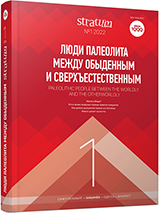Основные этапы и особенности заселения человеком северо-востока Восточноевропейской равнины и Урала в начале верхнего палеолита
The Main Stages and Specific Features of the Initial Peopling of the Northeast of East European Plain and the Urals at the Beginning of the Upper Palaeolithic
Author(s): Pavel Yu. PavlovSubject(s): Archaeology, Local History / Microhistory, Social history, Prehistory
Published by: Издательский дом Stratum, Университет «Высшая антропологическая школа»
Keywords: northeast of East European Plain; the Urals; initial peopling; Early Upper Palaeolithic; anatomically modern humans; Neanderthals;
Summary/Abstract: The article discusses the materials of the Early Upper Paleolithic sites of Zaozer’e, Garchi I and Byzovaya situated in the northeast of the East European plain and on the Urals (58—67°N; 50—60°E), in the Pechora and Upper Kama river basins. In this region, two episodes of initial human occupation are recognizable. The first (Zaozer’e site, 35—33 kyr BP) may represent the earliest penetration of anatomically modern humans into the north of Europe, while the second one (Garchi I and Byzovaya sites, ca. 29 kyr BP) can be associated with the migration of some Streletskian populations to the northeast of the European continent. The available evidence seems to indicate the cultural and chronological unity in the development of Paleolithic culture in the center and the northeast of the East European plain and on the Urals in the first half of the Upper Palaeolithic.
Journal: Stratum plus. Археология и культурная антропология
- Issue Year: 2022
- Issue No: 1
- Page Range: 129-149
- Page Count: 21
- Language: Russian
- Content File-PDF

